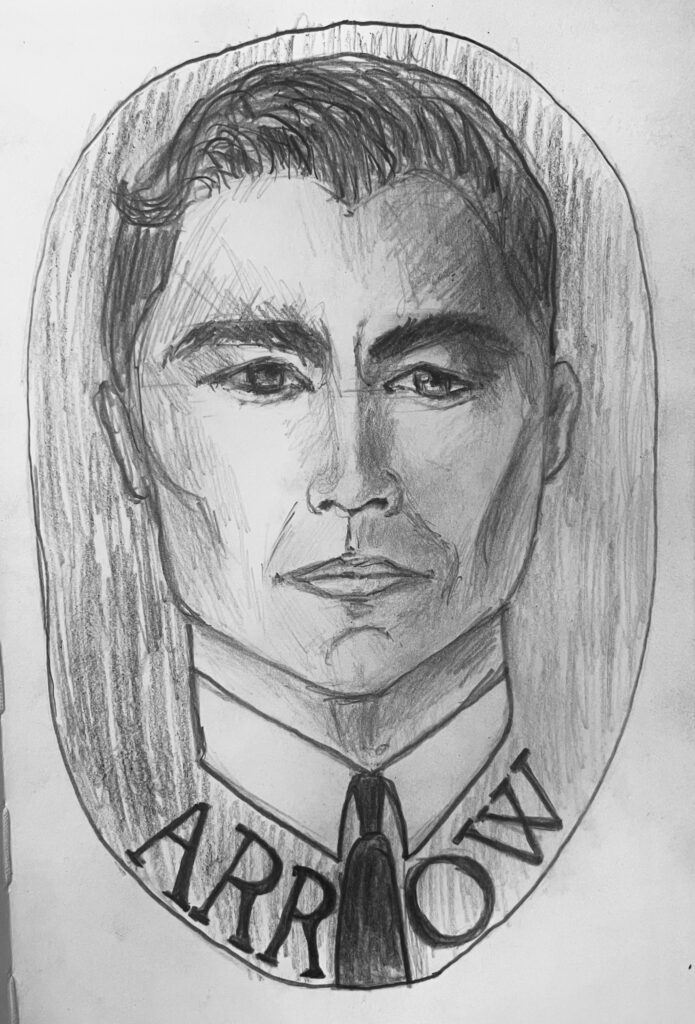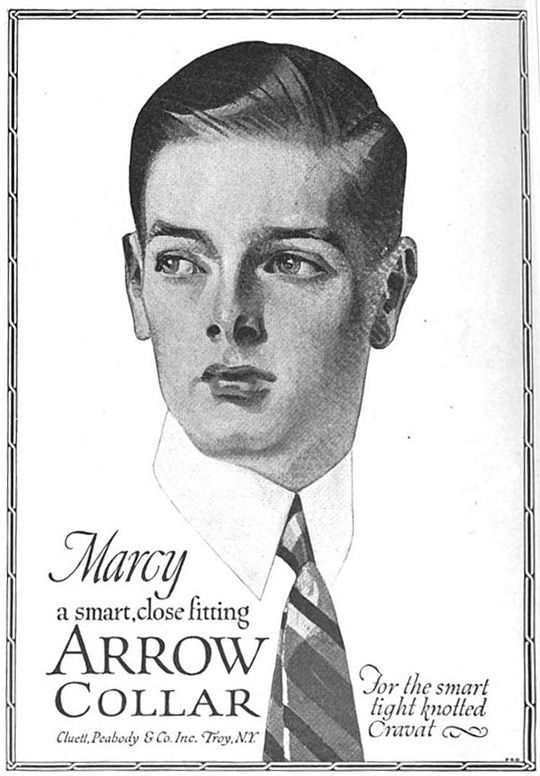In my project, I sketched a picture of Jay Gatsby (Leonardo DiCaprio) as an Arrow Collar advertisement. The Arrow Collar figure—originally drawn for Brooks Brothers shirts—was the ideal Jazz Age man, appearing in countless magazines and shaping the image of the wealthy, fashionable elite. I chose to draw Gatsby in this style to show how he presents himself as an advertisement, carefully curated to fit the mold of the ideal man. He shapes his identity around the lives of others in the upper echelons of society, using style and persona to fake his old money status.
In my research, I sourced an article describing the origins and cultural implications of the Arrow Collar style. Thomas Dilworth’s journal article explores how the persona was created and affected 1920s perceptions of masculinity, wealth, and ideals. By examining these ideas, readers understand how fashion and societal trends influence Gatsby’s persona, both within the 1920s setting of the novel and in the century since its publication. Gatsby’s identity relies heavily on the Arrow Collar style: the well-dressed, affluent, and culturally idolized masculine figure of the 1920s. Daisy’s iconic line in Chapter 7: “You always look so cool… You resemble the advertisement of a man,” alludes to this archetype, highlighting the materialistic values that dominate their society. Gatsby puts on a costume in an attempt to win Daisy’s affection and assimilate into the upper class. The article raises the question of whether class can be bought through wealth or if it is something inherited, and it presents Gatsby and Tom as foils—one a self-made facade, the other a born aristocrat. In the novel, materialistic pursuits and images are everything. Gatsby uses this Arrow Collar style as a façade, hiding his true identity and pretending to be like the character in the famous advertisement.
As an Advertising major, this idea stood out to me. It connected directly to what I’ve learned: advertising doesn’t just sell products—it sells an image, lifestyle, and in Gatsby’s case, the American Dream. Gatsby’s false demeanor functions in the same way. He markets himself as a product designed to appeal to Daisy and high society, but this image is hollow. His charm is illusionary, not authentic. Daisy’s compliment confirms this, reflecting how advertising convinces consumers that something is desirable not for what it is, but for the image it represents.
Nick captures this as well, describing listening to Gatsby as “skimming hastily through a dozen magazines.” The metaphor underscores Gatsby’s glamour and mystery, but also his lack of depth. Like a glossy magazine, his persona is all surface—polished, curated, and empty. This illusion draws people in but offers no real substance beneath.
Unbeknownst to Daisy, her remark encapsulates how a society obsessed with wealth and consumerism distorts love and identity. Gatsby’s life is deliberate, calculated to construct an image that fits Daisy’s world. But in doing so, he becomes a phony—lonely, hollow, and doomed. Fitzgerald uses Gatsby’s downfall as a critique of superficiality and the materialistic corruption of the American Dream, revealing the rot beneath the glittering advertisement that Gatsby is.
This idea represents my 21st Century Great Gatsby because the pursuit of personality and societal acceptance through materialism, style, and appearances remains deeply embedded in American culture even 100 years later. Social media aesthetics, celebrity fashion trends, advertising, and rampant consumerism place all of us in a position similar to Gatsby’s. The far-reaching implications of style influence more than just fashion—they reflect the condition of individual pursuits and identities. Just as Gatsby crafted a façade to gain love and acceptance, people today often construct carefully curated images to fit societal ideals. In both eras, the image takes precedence over authenticity, revealing how the illusion of success can mask inner emptiness.


